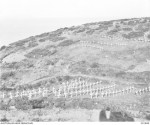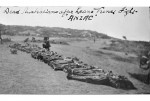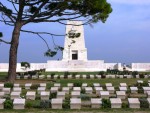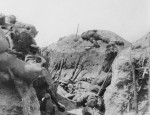LYONS, Stanley
Stanley Lyons was a fine young man, described as 'a brave, bright, honourable boy and one of the first to answer his country's call' by his foster mother, Frances Sheppard, and as 'a bright, manly and truthful boy' by his 'Auntie', Susannah Taylor. In truth, he had no relations, but he was also loved by a third woman, his landlady in East Melbourne, Mrs. Berkeley, whom he nominated as his next of kin.
Frances Sheppard, in a letter to the army authorities, told his story: 'The boy Stanley Lyons was an illegitimate child - his father not known - his mother left him when an infant with some people in Hindley St., Adelaide - deserted him and went to Western Australia ... the boy was brought to the State Children's Department and placed under my care. I mothered him and looked after him for years.' In another letter, she told more of his story: 'He absconded from the factory where he was working: Messrs. Pengellys of Edwardstown, because the foreman there told him he was only a bastard. He left a letter to me telling me he had gone to Melbourne to get work where he was not known, as no boy could stand that; he went away to make a name for himself amd serve his country.' Susannah Taylor concurred: 'he was a State illegitimate boy ... he always looked on her (Frances Sheppard) as mother and I, who was Sub-Matron, as Auntie. We dearly loved the lad.'
In Melbourne, he found a job as a driver, and a home at 13 Agnes St., Jolimont, with Mrs. Berkeley. He enlisted at Carlton on 15 August, 1914. He was a tall boy, 5' 11", with dark brown hair, aged just over 18 when he enlisted, Church of England by religious persuasion. He lied on his enlistment application, claiming to be 21. He had served 2 1/2 years with the Senior Cadets, B Company, Adelaide, so already had some military experience. After enlisting, he trained at Broadmeadows and was taken on strength with the 7th Battalion, B Company,AIF, comprising 30 officers and 940 men.
On 19 October, 1914, the Battalion left on HMAT Hororata, one of 28 Troopships from Australia, while another 10 ships conveyed New Zealand troops. The Convoy stopped in Columbo, before arriving in Egypt for further training, then headed off to the Gallipoli Peninsula via the island of Lemnos, where further preparations for the Anzac landing were made before leaving for Anzac Cove on 24 April. Stan Lyons would have been part of the second wave of soldiers landing at Anzac Cove on April 25, though his service record does not reflect this, nor that the 7th Battalion was then assigned to protecting the area they had won. On 6 May, however, the Second Brigade, of which the 7th Battalion formed part, was brought in to relieve the exhausted British troops fighting at Krithia, a poorly thought out campaign to open the way to the Turkish forts guarding the Dardanelles. Instead, the campaign was a bloodbath for the British troops and, following them in the 2nd Battle of Krithia (6-8 May), the New Zealanders and Australians. The greatest advance achieved was only 600 yards and the allies were met with strong Turkish resistance. In the belief that the Turks would be disorganised and poorly armed, the allied soldiers were ordered to run over open ground towards the Turkish positions. Medical provisions for the wounded, said one report, ' were woeful', as there was no point of collection for the wounded or vehicles to take them back to base, so stretcher bearers had to remove them one by one to take them to medical tents.
Stanley Lyons did not die in the assault on Krithia, but his appointment as Lance Corporal on 14 May reflects the losses suffered by his battalion. The 7th Battalion then retreated to Anzac Cove, defending the beach head and it is here that he met his death. His army record is brief: made Lance Corporal in one entry, the next records his death on 21 May, 1915. There was no battle as such, so he probably died from a random bullet or shell. It seems ironic that he had survived both the landing at Anzac Cove and Krithia, only to die when his battalion was out of the front line, some sources say 'resting'. He was buried at Brown's Dip Cemetery the same day he died, in Row 4 on 21 May.
Stanley Lyons' body was disinterred in 1923 and reburied at the Lone Pine Cemetery His name is listed at the Australian War Memorial Canberra in the Roll of Honour Cards 145 and on Panel 50 in the Commemorative Area. His possessions were sent back: one pocket book; one testament; some photos. He was only nineteen.
Australian War Memorial, Embarkation Roll, Roll of Honour, Unit History 7th Battalion
Australian National Archives, Service Record. (Citation: NAA: B2455, LYONS STANLEY)
Gallipoli and the Anzacs, War Graves Comission
Australian War Memorial, photographs of war graves, war dead
Ancestry.com.au Birth Index Stanley Lyons
John Edwards for reference to Trove image, email 16 June 2016:
Image of Private S. Lyons:
THE ROLL OF HONOR. (1915, September 30). The Express and Telegraph (Adelaide, SA : 1867 - 1922), , p. 4 (SPECIAL WAR EDITION). Retrieved June 17, 2016, from https://trove.nla.gov.au/newspaper/article/210111044
Text:
THE LATE PRIVATE S. LYONS.
Private Stanley Lyons, who fell in
action on June 15, was 19 years of age,
and was amongst first ten who en-
listed in the 10th Battalion in Mel-
bourne. He was educated at the Echunga
Public School and the Anglican Church
School. Being of a cheerful dis-
position he made many friends. He was
a ward of the State, and is mourned as
a son by his foster-parents.






